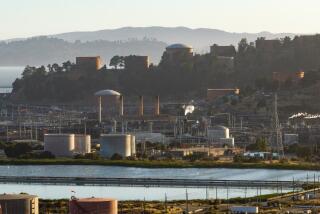Northrop Grumman moving headquarters from L.A. to Washington, D.C., area
In a blow to Southern California, Northrop Grumman Corp. said it would relocate its headquarters from Los Angeles -- leaving the region that gave birth to the aerospace industry without a single major military contractor based here.
The company said it would move its corporate staff to the Washington, D.C., area by summer 2011 to be closer to its key customer, the U.S. government.
Northrop’s announcement was seen as a bitter pill for the much-battered regional economy, which has suffered a series of high-profile corporate defections in recent years.
“This is very bad news, a crummy way to get 2010 started,” said economist Jack Kyser of the Los Angeles County Economic Development Corp. “It’s a prestige type of thing. Whenever a metro area loses a corporate headquarters, it smarts. We can’t forget.”
Northrop joins a parade of other companies that have left in recent years, including Hilton Hotels Corp. of Beverly Hills, Computer Sciences Corp. of El Segundo, Orange County’s Fluor Corp. and Science Applications International Corp. of San Diego.
The move came on the first working day for West Virginia native Wesley G. Bush, who succeeded longtime Chief Executive Ronald D. Sugar, who grew up in South Los Angeles and graduated from UCLA.
“This is an important move for the company, and it’s one that we believe will improve the effectiveness in serving the nation and our customers,” Bush said in his first public statement as the company’s chief executive. “The proximity to Washington enables us to be a more integrated part of the federal process.”
By relocating, Northrop brings its top executives closer to the nation’s decision makers on Capitol Hill, as well as U.S. military and intelligence customers, Bush said. The Pentagon is its largest customer. The company develops and makes a variety of products, including unmanned aircraft, satellites and nuclear submarines.
All told, Northrop is moving about 300 people from its corporate office in Century City.
Although the company is shifting some of its administrative staff, California will remain a significant location for Northrop operations, especially in research, development and manufacturing, Bush said. He noted that a quarter of Northrop’s worldwide workforce -- about 30,000 employees -- is in California, the vast majority in the Southland.
“We have been here, and will continue to be here, for a long time,” Bush said, noting that the company assembles a major component for the F/A-18 fighter jet in El Segundo, makes satellites in Redondo Beach, and develops robotic planes in Rancho Bernardo and Palmdale.
Still, Northrop will now lose its distinction as the last major aerospace firm based in Southern California -- once home to many of the nation’s largest military contractors, including Lockheed Corp., General Dynamics Corp. and Rockwell International.
“We were the capital of the aerospace industry prior to the collapse of the Soviet Union,” Chapman University economist Esmael Adibi said. “We had major firms in Southern California, with operations across different counties. But slowly, we are no longer an important player in that segment.”
Northrop was founded in 1939 in Hawthorne. During World War II aircraft manufacturing boomed in California, with factories running around the clock. The industry was so robust that communities such as Lakewood were spawned to house workers.
But by the late 1980s, aerospace manufacturing in the Southland had peaked. The end of the Cold War triggered a major retrenchment that led to consolidation of the industry.
During this time, the Southland’s industry evolved into one of high-tech design and research and parts suppliers. Although jetliners are no longer assembled in Southern California, it is still home to thousands of subcontractors that make parts for Boeing Co. and Europe’s Airbus, the only two makers of big commercial airliners.
That’s by design. By contracting work with suppliers throughout the U.S., military contractors build a political constituency with members of Congress whose states and districts benefit from the manufacturing jobs.
Northrop illustrates the trend. The company has about 120,000 employees scattered across 50 states and 25 countries, developing and building weapons and high-tech equipment that touch practically every aspect of U.S. military and intelligence operations.
Northrop’s planned move to be near the nation’s capital follows other big military contractors. Lockheed Martin Corp. and General Dynamics have also relocated to the Washington area.
Lockheed and General Dynamics have been two of the most successful companies in securing government contracts over the last 10 years, said Loren Thompson, a defense policy analyst for the Lexington Institute in Virginia. This is not something that Northrop’s top brass is likely to miss, he said.
“There’s only one customer in the defense business, and that’s the federal government,” Thompson said. “You can’t afford to be 3,000 miles farther away from your competitors.”
James McAleese, a lawyer in McLean, Va., who specializes in military contracts, said the decision to relocate was one that’s likely to be well received on Wall Street. “Wes Bush obviously wanted to make an impact in his first days on the job,” McAleese said. “He is being driven by the shareholders and the need to be responsive to the customers, which are in Washington.”
Northrop reported $33.9 billion in sales in 2008. Among military firms, it is second in sales behind Lockheed.
The company said it was scouting out locations in the District of Columbia, Maryland and Virginia, and planned to relocate corporate staff in the summer of 2011.
“The aerospace industry has long been a crucial linchpin to the California economy,” Rep. Jane Harman (D-Venice) said. “Thousands of men and women depend on it. And while Northrop’s move doesn’t signal that they are moving manufacturing jobs out of the state, it is still very disappointing.”
william.hennigan@
latimes.com
More to Read
Inside the business of entertainment
The Wide Shot brings you news, analysis and insights on everything from streaming wars to production — and what it all means for the future.
You may occasionally receive promotional content from the Los Angeles Times.












